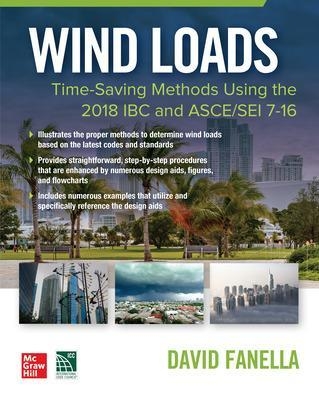
Wind Loads: Time Saving Methods Using the 2018 IBC and ASCE/SEI 7-16
Seiten
2020
McGraw-Hill Education (Verlag)
978-1-260-46742-0 (ISBN)
McGraw-Hill Education (Verlag)
978-1-260-46742-0 (ISBN)
Concise, visual explanations of code provisions that apply to wind loads
This practical guide provides engineers with a visual overview of the code provisions pertinent to wind loads. Free of complicated and confusing explanations, the book includes numerous design aids, figures, and flowcharts that clearly demonstrate the code provisions. Written by a recognized expert in the field, Wind Loads: Time-Saving Methods Using the 2018 IBC and ASCE/SEI 7-16 contains simplified, step-by-step procedures that can be applied to main wind force resisting systems and components and cladding of building and nonbuilding structures. Examples and companion online Excel spreadsheets can be used to accurately and efficiently calculate wind loads.
Coverage includes wind load requirements for:
Wind velocity pressure
Gust effects on rigid and flexible buildings and other structures
Main wind force resisting systems of buildings and other structures
Components and cladding of buildings and other structures
Enclosed, partially enclosed, partially open, and open buildings of all heights
Low-rise buildings
Roof overhangs and parapets
Building appurtenances and other structures
Solid freestanding walls and signs
Chimneys, tanks, open signs, single-plane open frames, and trussed towers
Rooftop structures and equipment
Circular bins, silos, and tanks
Rooftop solar panels
This practical guide provides engineers with a visual overview of the code provisions pertinent to wind loads. Free of complicated and confusing explanations, the book includes numerous design aids, figures, and flowcharts that clearly demonstrate the code provisions. Written by a recognized expert in the field, Wind Loads: Time-Saving Methods Using the 2018 IBC and ASCE/SEI 7-16 contains simplified, step-by-step procedures that can be applied to main wind force resisting systems and components and cladding of building and nonbuilding structures. Examples and companion online Excel spreadsheets can be used to accurately and efficiently calculate wind loads.
Coverage includes wind load requirements for:
Wind velocity pressure
Gust effects on rigid and flexible buildings and other structures
Main wind force resisting systems of buildings and other structures
Components and cladding of buildings and other structures
Enclosed, partially enclosed, partially open, and open buildings of all heights
Low-rise buildings
Roof overhangs and parapets
Building appurtenances and other structures
Solid freestanding walls and signs
Chimneys, tanks, open signs, single-plane open frames, and trussed towers
Rooftop structures and equipment
Circular bins, silos, and tanks
Rooftop solar panels
| Erscheinungsdatum | 15.01.2021 |
|---|---|
| Zusatzinfo | 96 Illustrations |
| Verlagsort | OH |
| Sprache | englisch |
| Maße | 191 x 234 mm |
| Gewicht | 436 g |
| Themenwelt | Technik ► Bauwesen |
| ISBN-10 | 1-260-46742-2 / 1260467422 |
| ISBN-13 | 978-1-260-46742-0 / 9781260467420 |
| Zustand | Neuware |
| Informationen gemäß Produktsicherheitsverordnung (GPSR) | |
| Haben Sie eine Frage zum Produkt? |
Mehr entdecken
aus dem Bereich
aus dem Bereich
Buch | Softcover (2024)
Springer Vieweg (Verlag)
18,99 €
Grundlagen und Vorgehensweisen
Buch | Softcover (2021)
Springer Fachmedien Wiesbaden GmbH (Verlag)
37,99 €
Grundlagen der Berechnung und baulichen Ausbildung von Stahlbauten
Buch (2022)
Springer Vieweg (Verlag)
159,98 €


